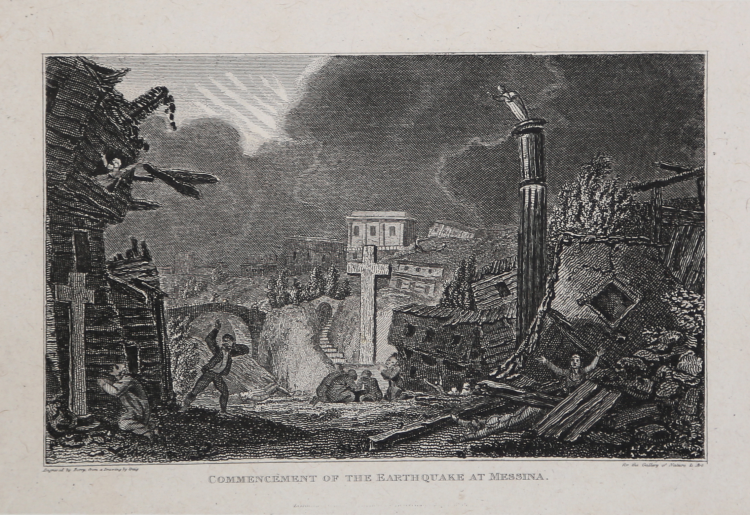


| Reference: | S11671 |
| Author | James BARRY |
| Year: | 1800 ca. |
| Zone: | Messina |
| Printed: | London |
| Measures: | 190 x 130 mm |


| Reference: | S11671 |
| Author | James BARRY |
| Year: | 1800 ca. |
| Zone: | Messina |
| Printed: | London |
| Measures: | 190 x 130 mm |
Small etching, printed on china paper, depicting the earthquake of Messina, 1783.
Printed by James Barry. Rare.
James BARRY (Cork, 11 ottobre 1741 – 22 febbraio 1806)
|
James Barry was born in Water Lane, Cork on 11 October, 1741. He first studied painting under local artist John Butts, and in 1763 went to Dublin, studying with Jacob Ennis at the Drawing Schools of the Dublin Society. The politician Edmund Burke took an interest in his career and in 1764 provided him with an introduction to Joshua Reynolds, President of the Royal Academy in London. Encouraged by Reynolds and financed by Burke, he visited the Continent in 1765 until 1771. Barry had high intentions, and aspired to be a great history painter, following in the footsteps of Mantegna and Poussin. The strong moral and social content in his paintings show him to be an early Neo-Classicist, yet his life was thwarted by a strong romantic temperament, an argumentative nature, and financial misfortune. After coming back to London in 1771, he turned to printmaking and illustrating in order to support himself. He also regularly exhibited works at the Royal Academy, becoming a member in 1773 and professor of painting in 1782. His famous cycle of history paintings at the Society of Arts was unveiled in 1783 to great acclaim, but Barry was paid a derisory £503 for his work. His outspoken criticisms directed against Sir Joshua Reynolds, the Academy, the Government and society in general eventually led to his expulsion from the Academy. Between 1783 and his death, he completed only four major history paintings, and none sold during his lifetime. He fell ill in 1803, and although Sir Robert Peel and the Society of Artists raised an annuity for him in 1805, he died in 1806.
|
James BARRY (Cork, 11 ottobre 1741 – 22 febbraio 1806)
|
James Barry was born in Water Lane, Cork on 11 October, 1741. He first studied painting under local artist John Butts, and in 1763 went to Dublin, studying with Jacob Ennis at the Drawing Schools of the Dublin Society. The politician Edmund Burke took an interest in his career and in 1764 provided him with an introduction to Joshua Reynolds, President of the Royal Academy in London. Encouraged by Reynolds and financed by Burke, he visited the Continent in 1765 until 1771. Barry had high intentions, and aspired to be a great history painter, following in the footsteps of Mantegna and Poussin. The strong moral and social content in his paintings show him to be an early Neo-Classicist, yet his life was thwarted by a strong romantic temperament, an argumentative nature, and financial misfortune. After coming back to London in 1771, he turned to printmaking and illustrating in order to support himself. He also regularly exhibited works at the Royal Academy, becoming a member in 1773 and professor of painting in 1782. His famous cycle of history paintings at the Society of Arts was unveiled in 1783 to great acclaim, but Barry was paid a derisory £503 for his work. His outspoken criticisms directed against Sir Joshua Reynolds, the Academy, the Government and society in general eventually led to his expulsion from the Academy. Between 1783 and his death, he completed only four major history paintings, and none sold during his lifetime. He fell ill in 1803, and although Sir Robert Peel and the Society of Artists raised an annuity for him in 1805, he died in 1806.
|